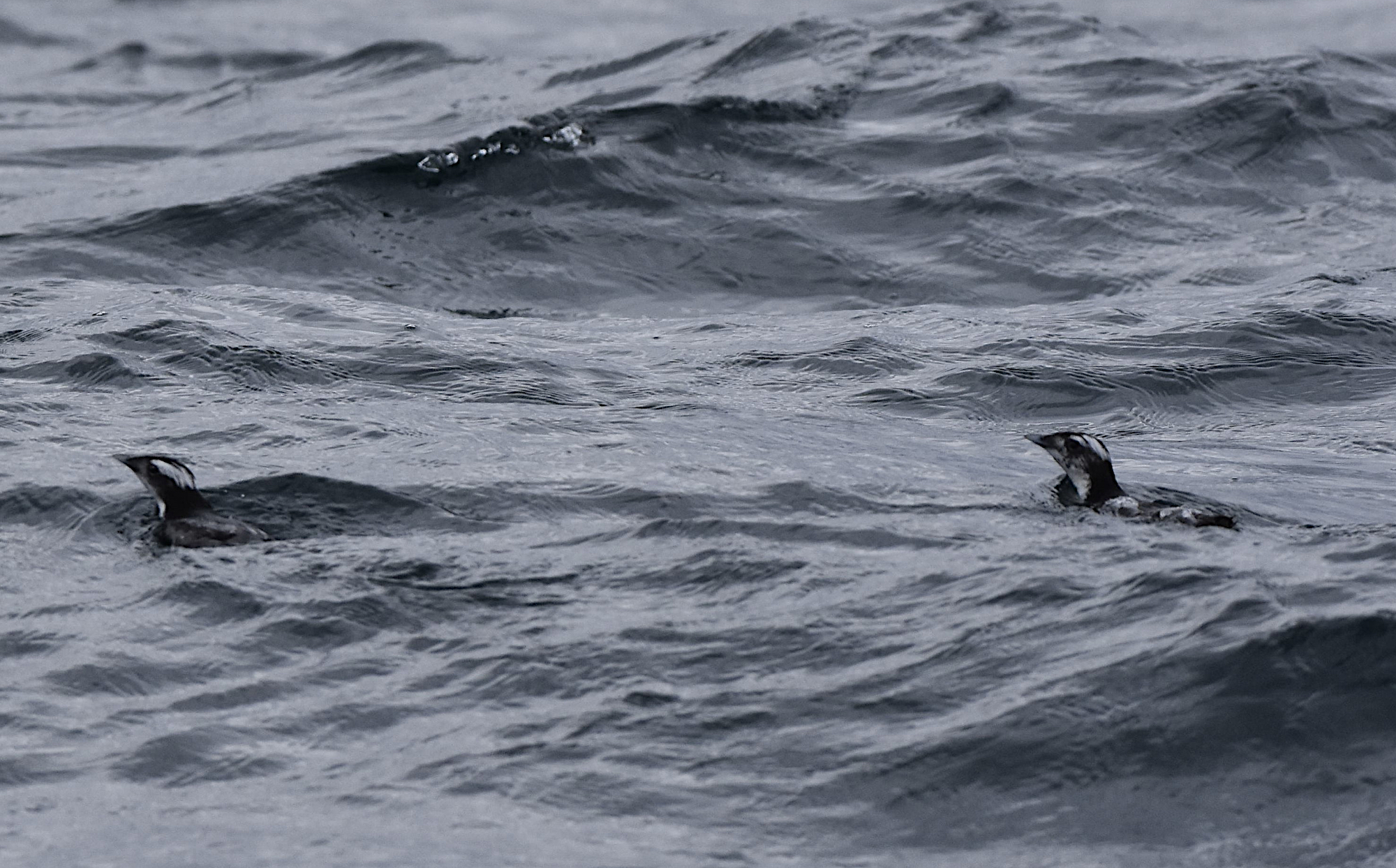Bird News from Nial Moores, with Kim Kimi and Lee Joon-Hyup ( Birjarim Ro Monitoring Team) and Kim Yeiwon on several dates.
Bird highlights during five days of survey at Bijarim Ro (still threatened by road-widening) and along the Seongsan Coast (close to the site of the proposed 2nd Jeju Airport) between February 19th and 23rd included: an extraordinarily un-seasonal Mugimaki Flycatcher at the Bijarim Ro (first national winter record?) along with a White-tailed Eagle and three Yellow-bellied Tit on the 19th; some close encounters with Crested Murrelets, Saunders’s Gulls and Black-faced Spoonbills along the Hado and Seongsan coast on 20th and 21st; brief encounters with Grey Bunting, Rhinoceros Auklet and an overwintering Richard’s Pipit on 20th and 21st; lots of interesting gulls, mixed groups of cormorants and good looks at the local Far Eastern Larks and Meadow Buntings; Light-vented Bulbul (still considered scarce on Jeju Island) at two or three locations; several groups of Dusky Thrush (perhaps including some on the move north) and my personal first Barn Swallow of the spring. It was also wonderful to catch sight of a pod of three dolphin, presumably Indo-Pacific Bottlenose Dolphin, passing not far off shore.




More detailed reports with species lists have already been shared with relevant bodies / organisations, including with the wonderful Bijarim Ro Monitoring Team and through them Jeju National University; and the similarly wonderful folks of the “People Caring for Seongsan’s Environment”. Some of the highlights/ species of interest included:
Horned Grebe 귀뿔논병아리. VU. One along the Seongsan coast.
Eurasian Woodcock 멧도요. Three seen together at dusk at the Bjiarim Ro, with walking tracks seen in several puddles.
Saunders’s Gull 검은머리갈매기 VU. On 21st and 23rd, while searching unsuccessfully for two Caspian Tern which have overwintered here, we instead found 10 Saunders’s Gull – regular here in winter along the coast between Hado Ri Wetland and Seongsan.

Caspian Gull-type 카스피해갈매기? One very striking looking bird (both structurally and in terms of plumage) stood out obviously from good numbers of similarly-aged Vega, Taimyr and Mongolian Gulls.



Ancient Murrelet 바다쇠오리. A total of 27 were counted along the coast on the 20th, and 15 were in one area on 21st.

Crested Murrelet 뿔쇠오리 VU. Up to seven were in one area on the 20th; and four were seen from our wave-splashed boat in the same area on 21st, with three of these skillfully photographed by local birder Kim Yeiwon.


Rhinoceros Auklet 흰수염바다오리. One on 20th. Kang et al. (2017) consider this a vagrant to Jeju, although the species in some winters is common along much of the east coast south to Busan and used to be regular in warm waters south to e.g. Fukuoka in Japan.
Pelagic Cormorant 쇠가마우지. A protected species in the ROK, 128 were counted along the coast on the 20th.

Great Cormorant 민물가마우지. Several were seen in mixed groups with the much commoner Temminck’s Cormorant. The question of how to separate hanedae remains.



Black-faced Spoonbill 저어새. Small numbers seen at three locations. Eastern Jeju is still by far and away the most reliable part of Korea to see this summer visitor in winter.

Pacific Reef Egret 흑로. Only four were seen along 20km or so of coast on the 20th. These exhibited quite a range in tone, however.


White-tailed Eagle 흰꼬리수리. One over the Bijarim Ro on 19th seems to be a very good find for Jeju Island as the species is considered a rare winter visitor by Kang et al. (2017).

Light-vented Bulbul 검은이마직박구리. One probable was heard briefly along the Seongsan coast on 20th; at least seven were around the Hado Ri Wetland on the 21st (with one in song there on 23rd) and one was heard along the Bijarim Ro on 22nd.

Barn Swallow 제비. One at the coast on 23rd.
Dusky Warbler 솔새사촌. Two in reeds at Hado Ri Wetland on 21st.
Mugimaki Flycatcher 노랑딱새. A First-winter male (with deep orange throat and breast; obvious wing bar and hint of pale patch above the eye) was seen well, if briefly, in fruiting trees on the Bijarim Ro on 19th. I am not aware of any Korean record of this species between December and mid-April. If you know otherwise, please send us a mail!
Richard’s Pipit 큰밭종다리. One was along the Seongsan coast on 20th. Jeju Island is the best area in Korea for finding this species in winter.
Meadow Bunting 멧새. Several individuals with blackish ear coverts and grey-washed throats – the typical look of birds on Jeju – were seen. One bird seen on 22nd, however, looked just like a typical mainland type.

Grey Bunting 검은멧새. In a forested hill near Seongsan, one group of five included at least one adult male; while two others were heard only on the same hill.
Reference
Kang CH., Kang HM., Kim BS., Kim EM. & Song IH. 2017. Jeju Wild Animal Field Guide. Published by Jeju Special Self-Governing Province and Jeju Wild Animal Research Centre.

